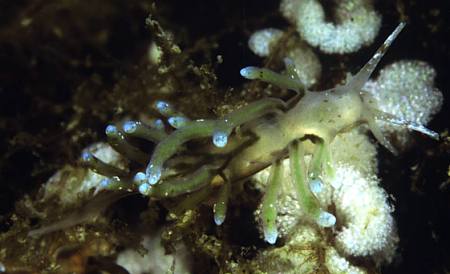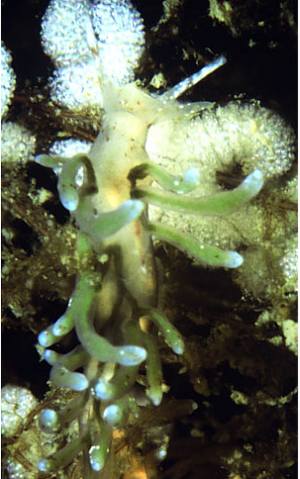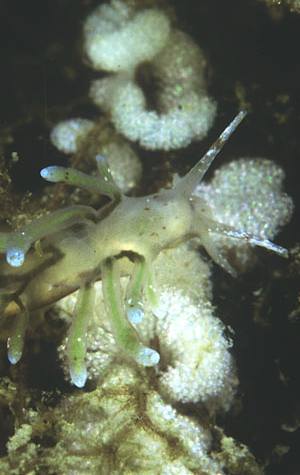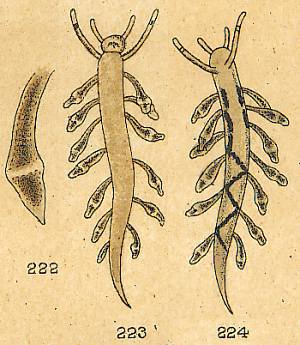Eubranchus olivaceus? from Massachusetts
May 28, 2003
From: Alan Shepard

NOTE added 14 July 2003: Following Jeff Goddard's message suggesting that E. olivaceus is a synonym of Eubranchus rupium, I have re-identified these east coast animals as E. rupium. - Bill Rudman
Bill -
Here are a couple of photos of Eubranchus olivaceus, a species you don't have represented on the Forum.
The photos were taken in Woods Hole, Massachusetts, USA under the Woods Hole Oceanographic Institute's pier in about 4 meters of water. I spotted a hydroid covered with eggs and easily found a number of E. olivaceus. They were all about 9 mm long.
According to Bleakney's book Sea Slugs of Atlantic Canada and the Gulf of Maine, it is a rare species first found on our coast in 1966 off Maine. It is also found on the west coast of the USA and Canada. I found a matching photo of one in David Behrens book, Pacific Coast Nudibranchs.
I'm not sure if the eggs in the photos belong to it or another species. All sources indicate that E. olivaceus is often found in the company of other Eubranchus species and Tergipes tergipes. In fact if you look closely at one of the photos you'll see what I believe is E. exiguus.
Sincerely,
Alan Shepard
alan.chepard@snet.net



Dear Alan,
This is an interesting find. Can you give me a date please? Reading O'Donoghue's description of Eubranchus olivaceus and the one photo I can find of it I have doubts about Bleakney's identification of your east coast animal. I am also pretty sure that it was found in Massachusetts a century before Bleakney's 1966 date. I have included here a scan of some paintings from Gould, 1870 [Plate 16] of what I think is the same animal.
Gould identifies it as Aeolis despecta Johnstone and describes it as:
"Animal colourless with a zigzag olive-coloured stripe along the back; branchiae large, ovate, in a single series along each side; dorsal tentacles long; angles of foot not produced. .... 'now and then zigzag stripe passes from one papillae to another on the same side. Orange ring about two thirds the way up the dorsal tents. Cerata much dilated near tip which is clear and transparent, in some aspects seeming as if encircled by a white ring. Hepatic substance [digestive gland duct] is olive green. Anterior angles of the foot rounded. Length about 1/4 inch.'"
Gould lists a number of records from Massachusetts. He also notes that the radula consists of a single row of teeth which suggests that he either missed the large lateral tooth on each side of the ventral tooth, or that this is not a species of Eubranchus. Perhaps this is a second species of Tergipes or perhaps Tergipes tergipes grows to a much larger size in Nth America than it does in Europe. The name Aeolis despecta Johnstone is based on European specimens and is a synonym of Tergipes tergipes. Clearly the first step would be to look at its radula.
•Gould, A. A. 1870. Report on the Invertebrata of Massachusetts, published agreeably to an order of the legislature. Second edition, comprising the Mollusca. Edited By W. G. Binney, v + 524pp. pls. XVI-XXVII. [Nudibranchia pp. 225-253, pls. 16-22]. Boston: Wright & Binney, State Printers.
Best wishes,
Bill Rudman
Related messages
-
Eubranchus olivaceus? from British Columbia
From: Laura McLeod, March 5, 2008 -
Eubranchus rupium? from British Columbia
From: Clinton Bauder, September 12, 2007 -
Eubranchus rupium with eggs
From: John de Jong, May 22, 2006 -
Re: Eubranchus olivaceus?
From: Alan Shepard, May 30, 2003 -
Eubranchus rupium from Holland
From: Rob Dekker, September 10, 1999
